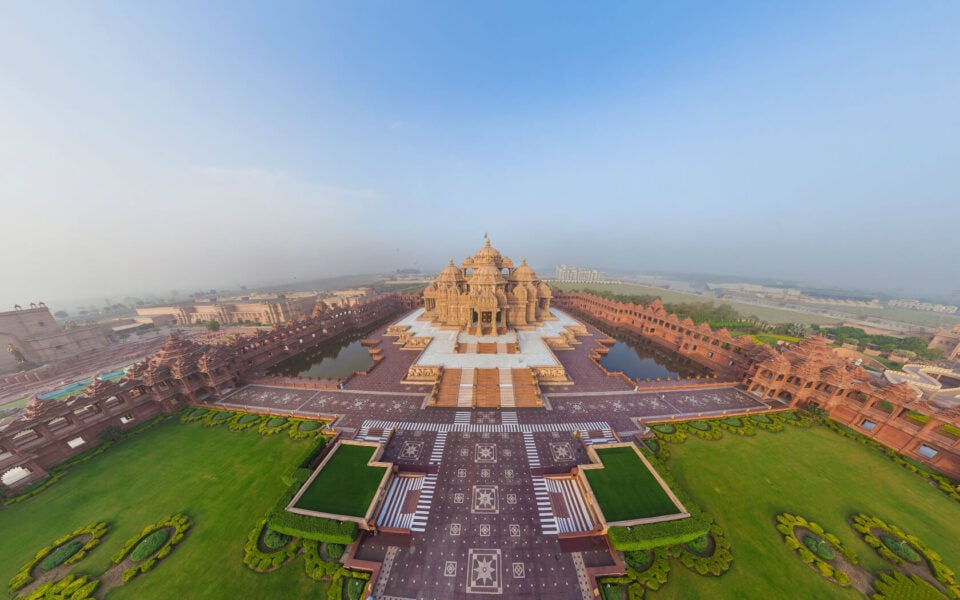Akshardham, Delhi – the largest Hindu temple, the construction of which took as much as 5 years and required half a billion US dollars. It impresses with its beauty and grandeur, strict safety rules and altruistic “approach to business”, because you can get to the territory of the complex completely free of charge.
General information
Akshardham Hindu temple complex, whose name translates as “the abode of God that cannot be moved”, is located on the banks of the Yamuna River. This is not only the largest, but also the most significant monument erected in honor of the culture and spirituality of India. In addition to the prayer house, which is the central part of the entire composition, the complex has magnificent parks, its own cinema, an artificial river channel, as well as numerous cafes, food courts and souvenir shops. Well, the most impressive element of the shrine is a small lake filled with water from all the reservoirs of India.
There is a lotus garden on the left and a fountain garden on the right. All this is surrounded by many different figures – from miniature caryatids to life-size monuments. Currently, Swaminarayan Akshardham in Delhi is one of the most visited tourist attractions in India. In addition, in its grandeur, it has long surpassed not only the legendary Taj Mahal, but also many other world-famous structures. For this feature, the temple was included in the Guinness Book of World Records.
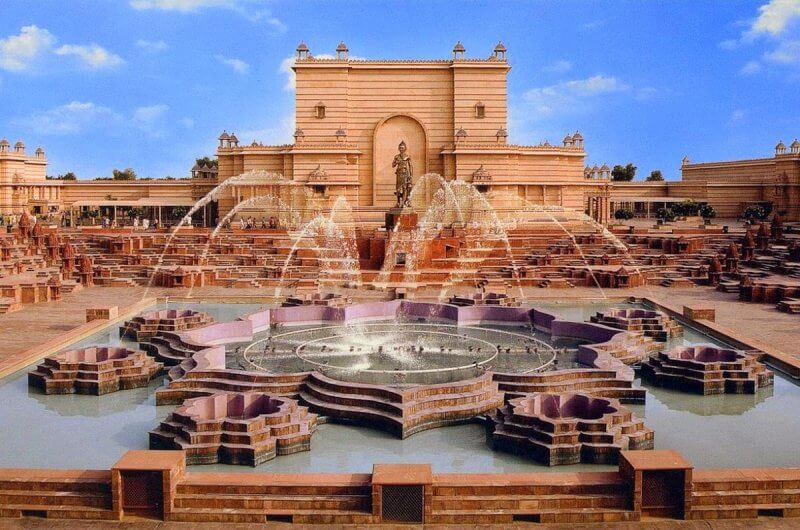
Historical background
The history of Akshardhama can be traced back to the 70s of the 20th century, when Yogiji Maharaj, the head of the spiritual center “BARS”, decided to build a unique sanctuary in Delhi dedicated to the great yogi and preacher Swami Narayan. However, he did not manage to realize his idea – Yogiji died of a sudden illness, and his project was covered with dust in one of the center’s boxes for many years.
The next time it was mentioned was in 1982, when a folder of drawings fell into the hands of one of the Maharaja’s successors. But this attempt was also unsuccessful, because the construction of the temple required simply unaffordable money – at least $ 500 million. It took another 18 years to collect this amount, which was raised through voluntary donations. And now, finally, it happened!
In 2000, the project management purchased 12 hectares of land on the banks of the Yamuna River and began construction of one of the most beautiful Indian attractions. At that time, about 10 thousand craftsmen, stonemasons and handymen who worked here for 5 years gathered in Delhi. The result of their work was a magnificent temple complex, the official opening of which took place in November 2005.
Temple architecture
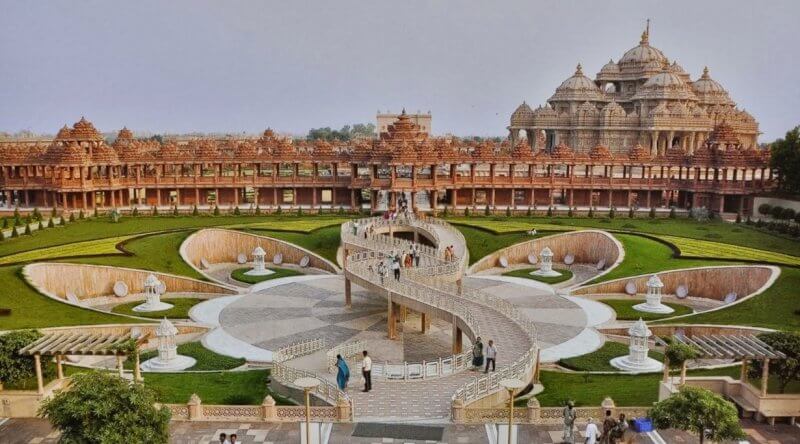
Looking at the photo of Akshardham in tourist avenues, it is impossible not to notice 10 huge gates, from which acquaintance with the modern monument of Hindu architecture begins. After passing through this gate, visitors enter the Mandir, a majestic prayer house that is 43 m high, 108 m long, and 96 m wide.
Akshardham Mandir, whose base rests on 147 elephant figures, is built of unique Rajasthan sandstone, pink granite and snow-white marble, symbolizing peace, purity and love of God. The first thing that catches your eye when looking at this structure is the refined pilasters located around the perimeter of the temple. All 234 columns are decorated with hand-carved patterns and scenes from Indian mythology.
Another feature of the prayer house is the huge number of statues erected in honor of numerous Hindu deities (murtiyas) — there are as many as 20 thousand of them. The walls of each of them are decorated with elegant figures of birds, animals and dancers. The Mandir itself is divided into several parts with spiritual and symbolic significance. All this splendor is crowned by 20 quadrangular spires and 9 domes decorated with elegant carved patterns.
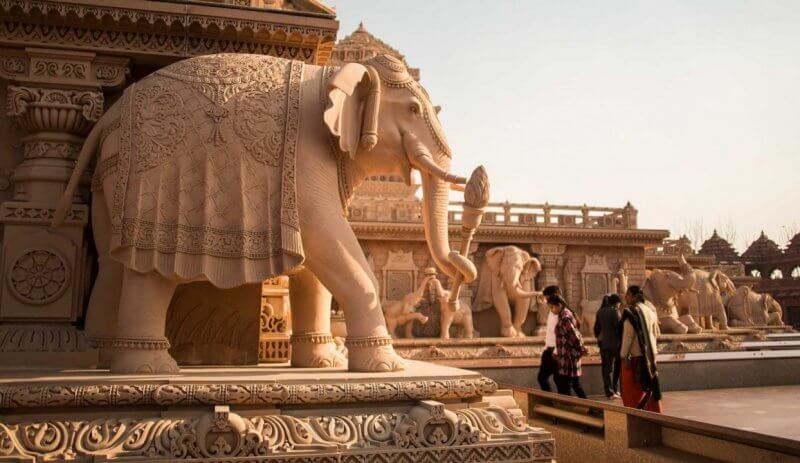
It is noteworthy that the construction of the temple complex was carried out without the use of a metal frame, and cement mortar is present here only in the foundation. But in this case, it was simply impossible to do without it, because Akshardham stands on the bank of the river. But the rest of the Mandir structures are prefabricated – they were not only assembled as one huge puzzle, but also turned over 90°, creating a complete and incredibly accurate drawing.
What’s inside?
Akshardham Mandir can be divided into 3 mandapams (themed spaces) connected by a chain of mazes. The first is a modern cinema hall with a huge multimedia screen broadcasting an entertaining 40-minute film about the life of the great teacher Narayan. And to make the show even more interesting, the image on the screen is accompanied by a number of visual and sound special effects.
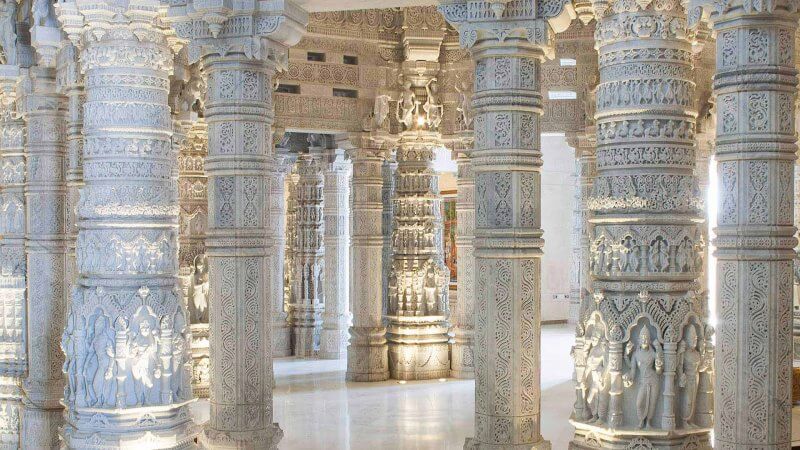
The next mandapam, called the Hall of Values, allows you to plunge into the history of the Indian people and feel like a direct participant in long-past events. Here, on every corner, you can see “live installations”, the actors of which are realistic robot dummies. Among them, the greatest curiosity is caused by the “Swaminarayan child”, represented by the smallest animatronic. Thanks to the ability to move, talk and gesture synchronously, “electronic people” successfully demonstrate individual scenes from the life of the famous Indian guru.
In the third hall of Akshardham, visitors will find an artificial river, along which regular boat trips are made. The trip is accompanied by soft music and a slow guide’s story about the development of ancient Indian culture. Boats connected by cables depart in 10-15 minutes. Each of them can accommodate no more than 15 people.
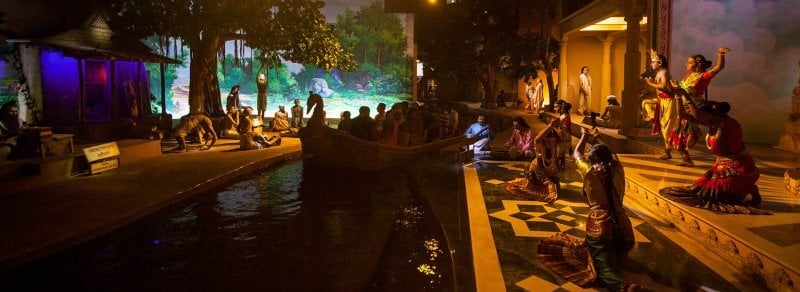
The interior of the temple deserves no less attention. Thus, the entrance doors of Akshardham are decorated with carved incarnations of Sri Vishnu, the walls are decorated with illustrations to ancient parables and images of Hindu deities, and the walls are made of white marble, inlaid with gilding and natural stones. The arched ceilings of the halls are supported by multiple columns reflected in the mirror surface of the polished floor, and the domed vaults amaze the imagination with their artful openwork weaving.
Another feature of the Mandir is a huge variety of sculptures, among which a special place is occupied by a 3-meter statue of Swami Narayan, installed under the central dome of the temple and surrounded by small statues of his students. In accordance with Hindu traditions, 5 different metals were used for their manufacture-copper, tin, iron, zinc and gold, silver or nickel (the latter metal was chosen depending on the sacred meaning of the product). A little further on, you can see rosaries, shoes and footprints of the great sage, as well as more than a dozen art canvases telling about his earthly existence. The remains of the guru are also kept in the alcove of the temple.
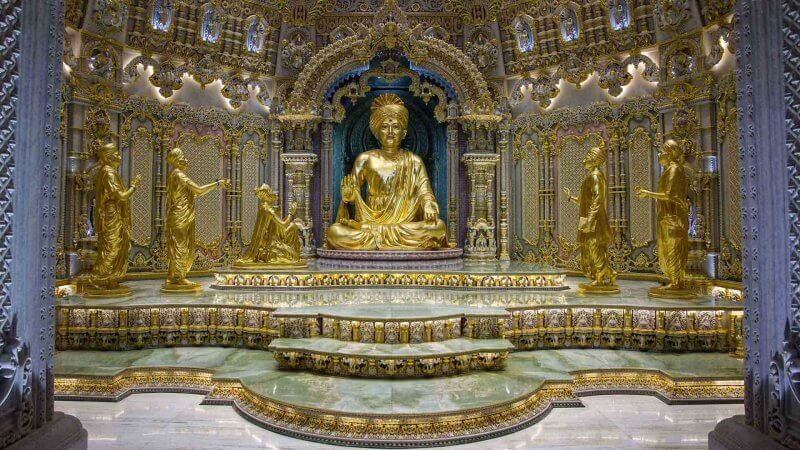
Water show
Looking at the photo and description of Akshardham in Delhi, you will probably come across information about the Sahaj Anand water show, which is held in the open air after dark. The main participants of this show are musical fountains made in the form of a lotus and placed inside a huge stone amphora. The inner surface of this bowl serves as steps (there are 2,870 of them here) and seats designed for several thousand spectators.
The design of the main pool, decorated with 9 lotus fountains, is an exact replica of the ritual yantra, a special pattern used in sacred Hindu ceremonies. In the center of this well is a bronze statue of Murti, which reaches a height of 8.5 m.
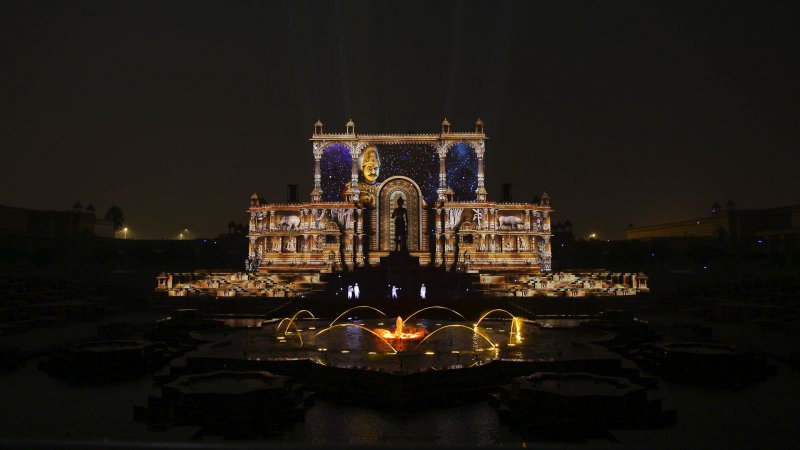
The show, which lasts about 20 minutes, combines several special effects at once-a video projection, multi-color lasers, glowing water jets and underwater flames. Combined with the skillful performance of real actors, all this creates a fascinating and incredibly entertaining presentation.
Entrance fee:
- Adults (over 12 years old) – $1.2;
- Children 4-11 years old – $0.7;
- Children under 4 years old – free of charge.
Rules of conduct

Certain rules of conduct must be observed when visiting the Mandir:
- Backpacks, bags, mobile phones, as well as photo and video equipment will have to be left in free storage rooms. You should not worry about their safety. First, each visitor is given a special token, and secondly, the storage employee will definitely take a picture of you together with the checked baggage.
- The security system in Akshardham provides not only passing a frame with a metal detector, but also a personal search of each tourist. Pockets are felt very carefully, so it is unlikely that you will be able to hide a prohibited item in them.
- A mandir, like any sacred place, requires an appropriate dress code. So, both women’s and men’s clothing should completely cover the shoulders, chest, upper arms, stomach and knees. Those whose appearance does not meet these requirements can take a free sarong (pay $ 1.5 and get it back when you return the sarong at the exit).
- At the entrance to Akshardham, not only hats are removed, but also shoes.
- All offerings in the temple are served with the right hand.
- If you want to rest or pray, do not sit with your feet facing the altar – take the lotus position or bend your legs under you. And one more thing-men sit in the left part of the hall, and women – in the right.
- No shouting or loud talk is allowed in the house of worship.
Practical information
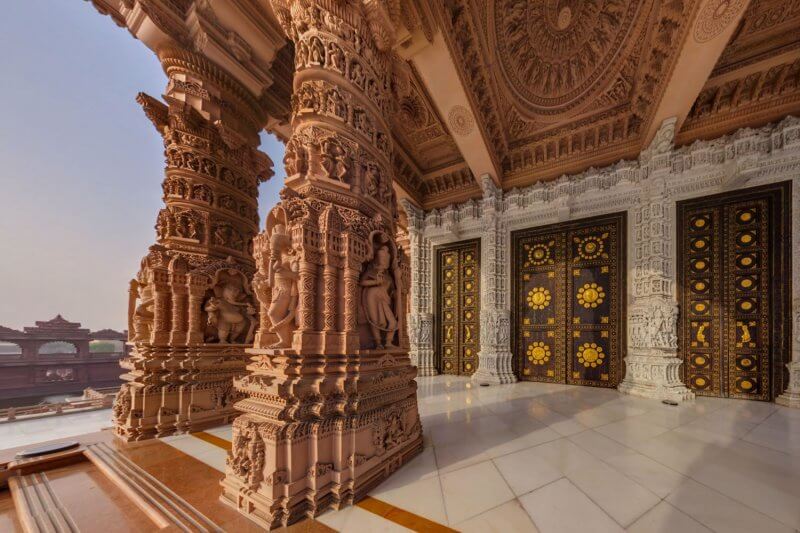
- Akshardham Temple, located at Nh 24 / Akshardham Setu, New Delhi 110092, India.
- It is open from Tuesday to Sunday from 09: 30 to 20: 00.
- Entrance to the complex is free. But excursions, water shows and photographers are available for a fee.
- For more information, see the official website — https://akshardham.com/
Useful tips
If you decide to visit Akshardham, Delhi, take note of some useful tips:
- When going to visit the temple, limit yourself to a purse or a small lady’s purse. Believe me, no matter how hard you try, you still won’t be able to bring a phone or video camera into the sanctuary. If you arrive light, you can avoid the huge queues that line up at the storage rooms. By the way, the largest number of people in front of it gathers before the start of the water show.
- The best way to get to Mandir is by metro – look for a station with the same name.
- Despite the hot climate, the temples are quite cool. Especially cold feet-you should bring socks.
- Official photographers work on site, so if you really want to bring at least 1-2 pictures from Akshardham, you can use their services.
- Guided tours of the temple are conducted in two languages – Hindi and English. There is one English-speaking group for 4-5 Indian groups. You may have to wait about half an hour for it to be formed, but it’s worth it – you can hear many interesting stories from the life of Bhagavan Swami Narayan.

